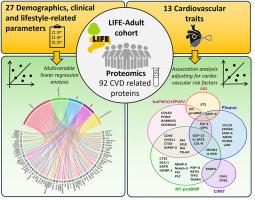基于人群的 LIFE-成人研究中蛋白质与亚临床心血管特征的关系
IF 4.9
2区 医学
Q1 CARDIAC & CARDIOVASCULAR SYSTEMS
引用次数: 0
摘要
背景和目的了解动脉粥样硬化性心血管疾病早期阶段的分子过程对于早期预测和干预措施至关重要。方法我们测量了基于人群的 LIFE-Adult 研究中 2024 名老年参与者的 92 种心血管疾病相关蛋白(Olink,心血管 III)。我们分析了 27 个协变量对这些蛋白质的影响,包括血细胞计数、心血管风险因素和生活方式相关参数。我们还分析了蛋白质与 13 种亚临床心血管特征的关系,包括颈动脉内膜厚度、斑块负荷、基于 Vicorder 的三种模式脉搏波速度、踝肱指数和基于 ECLIA 的脑钠肽 N 端前体(NT-proBNP)。共有 43 种蛋白质与所分析的亚临床心血管特征中的至少一种显著相关。NT-pro-BNP、肱踝脉搏波速度(baPWV)和颈动脉斑块负荷参数的相关性最大。关联重叠相对较少。只有生长/分化因子 15、低密度脂蛋白受体和白细胞介素-1 受体 2 型与这三种不同的心血管特征相关。我们证实了一些文献的研究结果,并发现颈动脉斑块的存在(von-Willebrand因子、galectin 4)、颈动脉内膜厚度(羧肽酶A1和B1)、baPWV(cathepsin D)和NT-proBNP(cathepsin Z、低密度脂蛋白受体、神经源性基因座同源蛋白3、trem-like转录本2)与之相关,但尚未报道。结论我们扩展了可能参与心血管疾病病理早期阶段的蛋白质组生物标志物目录,为早期风险预测或干预策略提供了目标。本文章由计算机程序翻译,如有差异,请以英文原文为准。

Relationship of proteins and subclinical cardiovascular traits in the population-based LIFE-Adult study
Background and aims
Understanding molecular processes of the early phase of atherosclerotic cardiovascular disease conditions is of utmost importance for early prediction and intervention measures.
Methods
We measured 92 cardiovascular-disease-related proteins (Olink, Cardiovascular III) in 2024 elderly participants of the population-based LIFE-Adult study. We analysed the impact of 27 covariables on these proteins including blood counts, cardiovascular risk factors and life-style-related parameters. We also analysed protein associations with 13 subclinical cardiovascular traits comprising carotid intima media thickness, plaque burden, three modes of Vicorder-based pulse-wave velocities, ankle-brachial index and ECLIA-based N-terminal prohormone of brain natriuretic peptide (NT-proBNP).
Results
Estimated glomerular filtration rate, triglycerides and sex where the most relevant covariables explaining more than 1 % variance of 49, 22 and 20 proteins, respectively. A total of 43 proteins were significantly associated with at least one of the analysed subclinical cardiovascular traits. NT-pro-BNP, brachial-ankle pulse-wave velocity (baPWV) and parameters of carotid plaque burden accounted for the largest number of associations. Association overlaps were relatively sparse. Only growth/differentiation factor 15, low density lipoprotein receptor and interleukin-1 receptor type 2 are associated with these three different cardiovascular traits. We confirmed several literature findings and found yet unreported associations for carotid plaque presence (von-Willebrand factor, galectin 4), carotid intima-media thickness (carboxypeptidase A1 andB1), baPWV (cathepsin D) and NT-proBNP (cathepsin Z, low density lipoprotein receptor, neurogenic locus homolog protein 3, trem-like transcript 2). Sex-interaction effects were observed, e.g. for spondin-1 and growth/differentiation factor 15 likely regulated by androgen response elements.
Conclusions
We extend the catalogue of proteome biomarkers possibly involved in early stages of cardiovascular disease pathologies providing targets for early risk prediction or intervention strategies.
求助全文
通过发布文献求助,成功后即可免费获取论文全文。
去求助
来源期刊

Atherosclerosis
医学-外周血管病
CiteScore
9.80
自引率
3.80%
发文量
1269
审稿时长
36 days
期刊介绍:
Atherosclerosis has an open access mirror journal Atherosclerosis: X, sharing the same aims and scope, editorial team, submission system and rigorous peer review.
Atherosclerosis brings together, from all sources, papers concerned with investigation on atherosclerosis, its risk factors and clinical manifestations. Atherosclerosis covers basic and translational, clinical and population research approaches to arterial and vascular biology and disease, as well as their risk factors including: disturbances of lipid and lipoprotein metabolism, diabetes and hypertension, thrombosis, and inflammation. The Editors are interested in original or review papers dealing with the pathogenesis, environmental, genetic and epigenetic basis, diagnosis or treatment of atherosclerosis and related diseases as well as their risk factors.
 求助内容:
求助内容: 应助结果提醒方式:
应助结果提醒方式:


